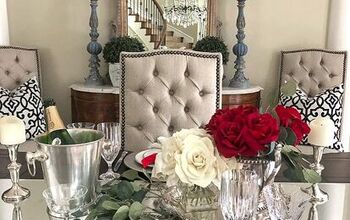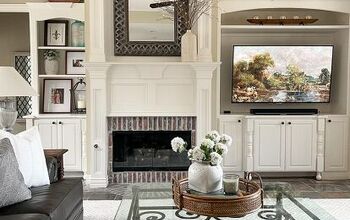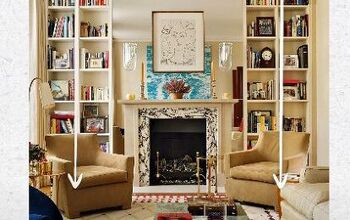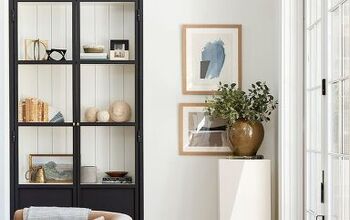How to Avoid Arguments When Decorating Your Home

If you and your partner can't seem to agree on anything when it comes to decorating your home, don't worry! You're not alone. In fact, this is a super common design dilemma.
You can of course watch this video on your own, but I highly recommend you also watch it together with your partner and pause the video after each section to discuss how each of you feel.
You might be surprised at what you discover!
Table of contents
Most arguments either arise from money or there can be various disagreements about style. We're going to cover all of those things, but let's start with money:
1. Discuss finances first
Decorating a house can cost money, and sometimes not everyone is on board with how that money should be allocated and spent. If you can come to an agreement on this, you will avoid ninety percent of future arguments.
You might want to spend ten thousand dollars on furniture, or maybe your partner only wants to spend a thousand. Until you've had a proper conversation about this and reached an agreement, you will never be able to decorate your home without frustration.
If you're only dealing with one room, then this might be pretty straightforward in terms of budget. But if you need to decorate a whole home, this can be a lengthy process. So, allow it the time it needs.
In our case, I buy some things without checking in first, but when they're kind of beyond a certain amount, then we'll discuss it.
Everyone's threshold is different. You might need to discuss every dollar spent, or maybe not. It depends on what you're doing and what your finances look like.
The point is, make sure you guys are on the same page when it comes to finances.
2. Discuss Priorities
Not discussing what's important to both of you will inevitably lead to frustration, misunderstandings, and arguments.
Make sure you both prioritize a few things you want, not too many, and start there. If one of you really wants a nice couch and the other wants a beautiful bed, for example, make sure you can both get what you want while still staying within budget.
If you need other essentials as well, then make sure you allow a bit of leeway for buying the rest of your furniture at, say, secondhand stores or on Facebook Marketplace. You can always upgrade the lower-priority pieces later, of course.
Priorities and what's important to each person in the relationship can also change over time, and that's okay.
But if you never talk about priorities with your partner, then you might not know that, for example, garage storage is really important to your partner and that every time they walk into the garage they get stressed because they can't find anything.
I like to keep lists for each room that I'm decorating and write down all the things I need versus all the things I'd like to have. That always helps me stay on track.
Then I revisit those lists from time to time and kind of check in with myself and see if I still feel the same way about what's on there. If you both do this, you can compare lists and always make sure that nobody gets left behind.
So, the moral of the story is make sure you're both on board with which areas or rooms or items are most important to each person and go from there.
3. Discuss Style
If your styles are extremely different, like for example one of you loves traditional and the other contemporary, problems may begin to surface.
It's important for everyone in a household to be happy with their surroundings. So, take the time to sit down with your partner and talk about what kind of style you both like.
You may want to try looking at some design magazines or websites together to get an idea of what you both like, or create a Pinterest board each and then compare them, which is also really fun by the way.
Definitely don't skip this as it's going to make everything much easier if you have a general idea of each other's taste. Look at pictures together and ask your partner what they like about their favorite images.
Is it the style of furniture? Is it the color palette? Is it something else?
It might take a little practice as some people are better at articulating these things than others, but this is going to give you a deeper understanding of what they're drawn to. You'll really want to try and understand which elements are important to each of you and why.
And don't forget to take notes because it's really easy to forget the little details.
4. Compromise
The last thing you want is for your design to come to a complete standstill because you can't agree on what color something should be, where the sofa should go, or how much to spend on something.
I'm no relationship counselor, but if you're looking to keep the peace in your relationship, it definitely helps if you can compromise on things.
When it comes to compromising on interior design choices, there are some things that are easier to compromise on than others.
For example, furniture layout, which is something that even we argued over, is a pretty easy one though. With layout, just try things one way for one month and then try the other person's way for another month and see what feels best.
But if there are other points of contention that you're getting stuck on, then really try to understand why the other person feels so strongly about that particular thing.
If you can understand where the other person is coming from, then you might end up discovering that it's easier to find a compromise that still satisfies both of your needs.
When trying to compromise, it also really helps to go back to looking at your budget, referencing your list of priorities, and your style preferences, and base your compromise on things you've already spent time working on as a couple.
5. Shop Together
Tired of getting unpleasant reactions every time you come back from HomeSense? Then try shopping together! You don't actually even need to buy anything; it can just be window shopping.
If all you can do is browse online, that's fine too, but it's even more fun if you can do it in real life in real physical stores. It's just so much more engaging to be able to shop in person and interact with furniture and decor rather than just looking at a picture online.
By doing this, you can really get an idea of what the other person likes and dislikes just by seeing what they're drawn to in store. It's also a great opportunity to find unexpected things that you both love.
6. Two Designers?
If you're both really into design and you're arguing and it's hard to get anything done because you both have ideas and visions and you can't agree, well, if that's you, then an option for your situation is to join forces to design the common areas together and then divvy up the other parts of the home so that you each have an area that is yours to design or decorate.
Do you risk creating a home that looks disjointed that way? Some may think so, but if you've discussed style with each other and you're checking in with each other throughout the process, then you'll be okay.
Here's something that should be its own topic, but I'll just mention it here: trust.
If you do go that route where you each decorate different areas of the home, you'll need to be able to relinquish control and let go and trust that your partner has their situation under control.
If cohesion is something that is really important to you, well then that's something that should be communicated so that it can be taken into account. Right, it's all part of the process.
7. Be Respectful & Communicate
You might not like something, but what if your partner does? It's important to be respectful of each other's tastes, no matter how bad it might seem. Again, really try to understand why they love something before nixing it, and don't always try to push your own taste on the other person.
Remember, it's their home too.
At the same time, if there's something that you're really not comfortable with, then you need to be able to voice that. Just don't be a jerk about it. Remember to communicate.
If one of you starts to feel left out or like you're not being heard, that's when problems can start to arise. Make sure you're checking in with each other often. You should also try to be open to feedback from your partner, even if it's not what you were hoping to hear.
It can be easy to get attached to certain ideas, but at the end of the day you're doing this together and you need to make sure that both of you are happy with the final result.
8. Keep Organized
Sometimes you see something super inspiring on Pinterest and it sparks an idea in your mind for your space, and it's perfectly clear in your own head, but when you go to explain it to your partner, they really don't understand your vision.
So you get frustrated, and the worst part about this is that what could have been a potentially really great idea gets scrapped because you didn't present things properly. So don't make that mistake!
Just like with any design project, you need to save your ideas and inspiration somehow for yourself so that you can keep tabs on things, but also for something to use as reference for when you have a design conversation with your partner.
This can be a simple mood board in Photoshop or a Pinterest board, or whatever tool makes sense to you.
The important thing is that (a) you're saving your imagery somewhere and (b) you have a tool available that enables you to have a conversation about your design ideas when the need arises.
9. Ask a Pro for Help
If you've tried everything and it feels like you're stuck, you're arguing, and you're at a standstill with the design, then you can always consider hiring a designer (or a therapist!), even if it's just a consultation.
Sometimes it really does help to have an unbiased third party come in and help you figure out what the heck you should do with your space.
How to Avoid Arguments When Decorating Your Home
Designing a home with a partner can be a really fun and rewarding experience, and I really hope that some of these ideas help you overcome any roadblocks that you encounter so that you can develop your own system that works for both of you.
What was the number one thing that helped you when you decorated with your partner? I would love to know, so share below.



























































Comments
Join the conversation